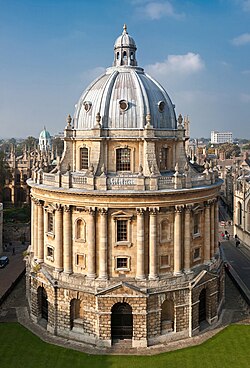
Back قمرة رادكليف Arabic Cambra Radcliffe Catalan Radcliffe Camera Danish Radcliffe Camera German Cámara Radcliffe Spanish Radcliffe Ganbera Basque ردکلیف کمرا Persian Radcliffe Camera French Radcliffe Camera Irish ラドクリフ・カメラ Japanese
| Radcliffe Camera | |
|---|---|
 Radcliffe Camera, viewed from the University Church | |
| Former names | Physics Library |
| Alternative names | Rad Cam or Radders or The Camera (colloquial) |
| General information | |
| Type | Academic library |
| Architectural style | English Palladian style |
| Location | Radcliffe Square, Oxford |
| Coordinates | 51°45′12″N 1°15′14″W / 51.7534°N 1.2539°W |
| Construction started | 17 May 1737 |
| Completed | 1748 |
| Inaugurated | 13 April 1749 |
| Owner | University of Oxford |
| Technical details | |
| Floor count | 2 plus a mezzanine |
| Design and construction | |
| Architect(s) | James Gibbs |
The Radcliffe Camera (colloquially known as the "Rad Cam" or "The Camera"; from Latin camera, meaning 'room') is a building of the University of Oxford, England, designed by James Gibbs in a Baroque style and built in 1737–49 to house the Radcliffe Science Library. It is sited to the south of the Old Bodleian, north of the Church of St Mary the Virgin, and between Brasenose College to the west and All Souls College to the east. The Radcliffe Camera's circularity, its position in the heart of Oxford, and its separation from other buildings make it the focal point of the University of Oxford, and as such it is almost always included in shorthand visual representations of the university. The Radcliffe Camera is not open to the public.
The library's construction and maintenance was funded from the estate of John Radcliffe, a physician who left £40,000 upon his death in 1714. According to the terms of his will, construction only began in 1737, although the intervening period saw the complex purchase of the site. The exterior was complete in 1747 and the interior finished by 1748, although the library's opening was delayed until 13 April 1749.
Upon its completion, Francis Wise was appointed as its first librarian. Until 1810, the library housed books covering a wide range of subjects, but under George Williams it narrowed its focus to the sciences. Williams brought the library from a state of neglect up to date, although by 1850 the Radcliffe Library still lagged behind the Bodleian. It was at this point that Henry Wentworth Acland, then librarian, laid out plans for the Radcliffe Library building to merge with the university and the library's collection of books to be moved to the newly constructed Radcliffe Science Library, which were accepted by the library's trustees and the university. It was at this point that the building became known as the Radcliffe Camera, serving as a reading room for the Bodleian.
